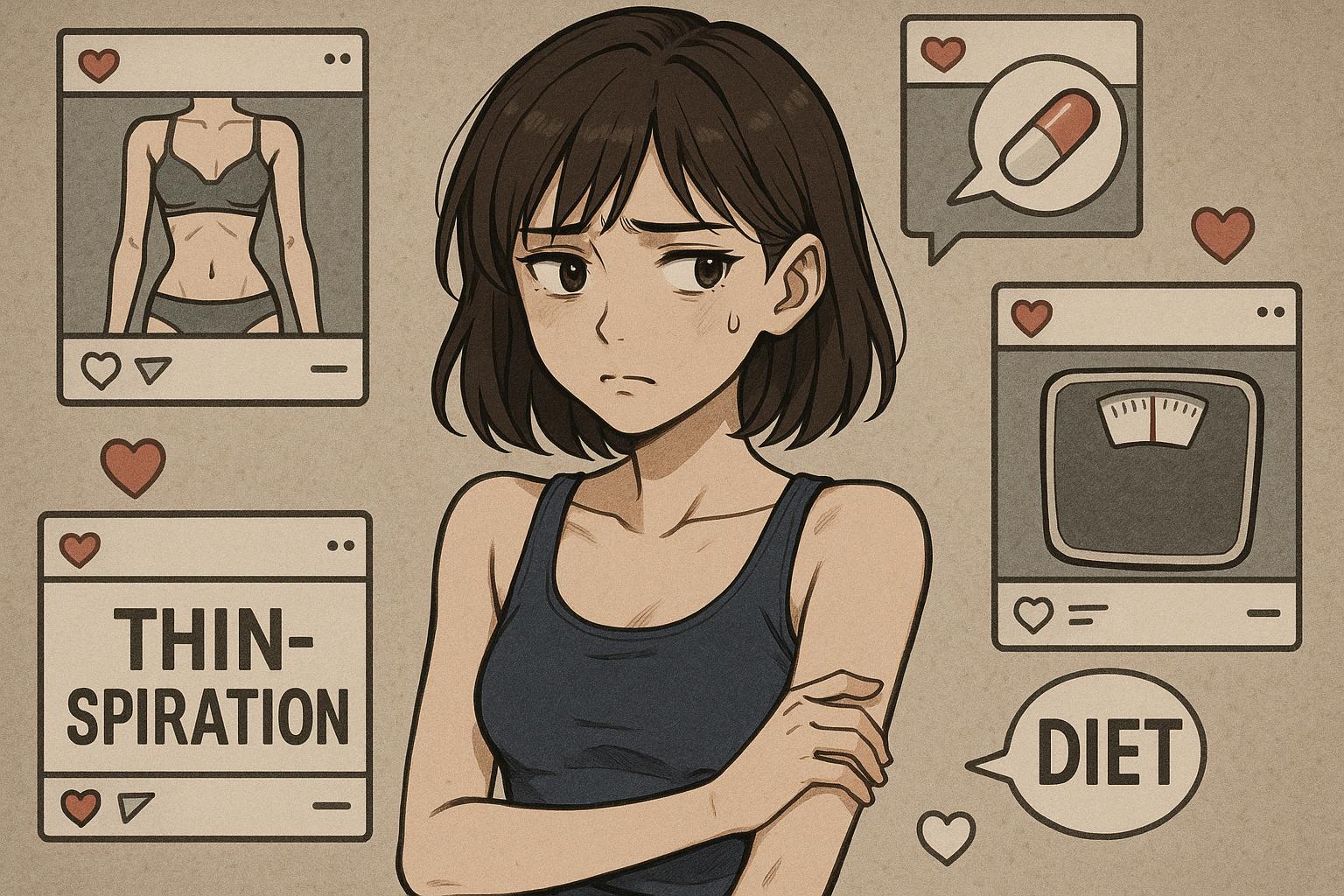Nearly a decade after Ashley Graham’s landmark Sports Illustrated cover, cultural attitudes are regressing towards dangerous thinness ideals, boosted by weight-loss drugs like Ozempic and TikTok’s SkinnyTok trend, with health experts warning of an alarming rise in disordered eating and body image crises among young people.
The body positivity movement, once heralded as a beacon of inclusivity and self-acceptance, seems to have receded into the shadows, with contemporary culture spiralling back towards the obsessive pursuit of ultra-thinness. Ashley Graham’s groundbreaking role as the Sports Illustrated swimsuit issue cover girl in 2016 marked a significant milestone in representation. Yet, nearly a decade later, the celebrations surrounding such progress are overshadowed by a new phase of cultural body image turmoil, now described as “Ozempic chic.” This phrase encapsulates not only the rise of extreme weight-loss drugs like Ozempic but also a resurgence of social media trends that promote unhealthy dieting practices.
At the forefront of this alarming trend is the rise of “SkinnyTok,” a subgenre of TikTok dedicated to glorifying restrictive eating and extreme thinness. Influencer Liv Schmidt epitomises this movement, with her content reportedly fostering a community that celebrates minimal food intake while downplaying the negative consequences of such lifestyles. Health experts have raised red flags about the impact of this content, warning that it normalises disordered eating and body dysmorphia among young viewers. Abbey Sharp, a registered dietitian and founder of Abbey’s Kitchen, underscores the danger by stating that platforms like TikTok are inundating impressionable users with harmful messages. She notes, “SkinnyTok glamorizes and normalizes disordered eating and body dysmorphia, especially among young, vulnerable viewers,” highlighting the profound influence of these content creators on their followers’ perceptions of health and self-worth.
Despite Schmidt being banned from TikTok for promoting extreme dieting, her influence has been considerable. With a following of over 600,000 before her removal, her content often included dangerous tips, such as eating only three bites of food per meal, justifying this as a principle of enjoyment rather than sustenance. Such messaging has drawn criticism not only for promoting weight loss but also for fostering harmful behaviours. Academic voices such as Mallary Tenore Tarpley, a professor at the University of Texas, indicate that these discussions have veered into dangerous territory, with followers sharing extreme tactics that can trigger or worsen eating disorders.
As discussions surrounding eating disorders intensify, it is important to underline the precarious position of many young women and men who are exposed to these toxic narratives. Eating disorders, as noted by Sharp, can be devastatingly lethal. Statistics indicate that anorexia nervosa, affecting nearly 30 million Americans, has the highest mortality rate of any mental illness. Experts widely contend that the current cultural obsession with thinness—propelled by the availability of weight-loss jabs like Ozempic—exacerbates these issues.
This shift towards an extreme dieting culture has been echoed in fashion and celebrity circles. The latest size inclusivity reports from Vogue Business reveal a stark decline in the representation of mid-size and plus-size models on runways, with only two per cent of models being classified as mid-size and a mere 0.3 per cent considered plus-size during recent fashion weeks. Furthermore, high-profile figures, including Oprah Winfrey and Rebel Wilson, have publicly acknowledged their use of such medications for weight loss, reinforcing harmful stereotypes around the need for drastic measures to achieve societal beauty standards.
The impacts of this pervasive culture extend beyond individual choices; they have established a backdrop against which entire communities are pressured to conform to an unattainable ideal. Sharp articulates how this contemporary obsession can lead to a moral reckoning among those who once took pride in their hard-earned thinness. “When you can essentially buy your way to a thinner body, it threatens those who have built identity capital and earned moral value around achieving or maintaining thinness the ‘hard way,’” she explains, mapping out a complex reactionary cycle that threatens to entrench diet culture even further into social consciousness.
Conversely, some experts point to the necessity for proactive discussions within families about body image and healthy eating behaviours. Tarpley advocates for a balanced perspective, where both parents and children can engage in open dialogues about self-worth, temporality of body image, and the importance of nurturing a healthy relationship with food. “I tell my kids all bodies are worthy of respect,” Tarpley shares, suggesting that cultivating a culture of body neutrality, where bodies are seen not so much as decorations but as instruments for living, might be the path forward.
While it is unrealistic to expect the allure of diet culture to vanish, flipping this narrative may provide a much-needed buffer against its potentially harmful effects. It has become crucial now more than ever to advance the dialogue around body image variability, with a collective hope that society can lean towards a healthier, more inclusive understanding of self-identity in an age deeply marked by external influences.
Reference Map:
- Paragraph 1 – [1], [4]
- Paragraph 2 – [1], [2], [5]
- Paragraph 3 – [3], [6]
- Paragraph 4 – [2], [4], [7]
Source: Noah Wire Services
- https://www.dailymail.co.uk/femail/article-14751455/Ozempic-chic-women-dieting-weight-loss.html?ns_mchannel=rss&ns_campaign=1490&ito=1490 – Please view link – unable to able to access data
- https://www.dailymail.co.uk/femail/article-14751455/Ozempic-chic-women-dieting-weight-loss.html?ns_mchannel=rss&ns_campaign=1490&ito=1490 – The article discusses the resurgence of ultra-thin beauty standards, termed ‘Ozempic chic,’ driven by the popularity of weight-loss drugs like Ozempic. It highlights the rise of ‘SkinnyTok,’ a TikTok subculture promoting extreme dieting and disordered eating, exemplified by influencer Liv Schmidt. Schmidt’s content, which includes promoting minimal food intake and restrictive eating habits, has been linked to normalising disordered eating and body dysmorphia among young viewers. Health experts express concern over the impact of such content on body image and the potential for developing eating disorders.
- https://www.valueyournetwork.com/en/skinnytok-risky-trend/ – This article examines ‘SkinnyTok,’ a TikTok subculture where users, primarily young women, share content centred around achieving and maintaining extreme thinness. The content often includes tips for rapid weight loss, appetite suppression techniques, and promotion of an aesthetic that glorifies being underweight. The article highlights the dangers of such content, including the potential to fuel body dissatisfaction, trigger eating disorders, and exacerbate existing mental health issues. It also discusses the role of TikTok’s algorithm in amplifying these harmful trends.
- https://www.indy100.com/news/skinnytok-social-media-obsession-thinness – The article explores the ‘SkinnyTok’ trend on TikTok, where content promoting extreme thinness and disordered eating behaviours is prevalent. It discusses TikTok’s efforts to address the issue, including age-restricting content that idealises certain body types and implementing tools to help users filter harmful content. Despite these measures, the article raises concerns about the effectiveness of enforcement and the persistence of deeply rooted cultural obsessions with thinness online. It also provides resources for individuals affected by eating disorders.
- https://www.washingtonpost.com/business/2024/05/20/tiktok-ozempic-weight-loss-body-shaming/ – This article reports on TikTok’s new rules aimed at curbing promotional videos related to weight-loss drugs like Ozempic. The platform’s changes intend to block body-shaming imagery and related harmful messages, disrupting a commercial ecosystem that has raised concerns about inappropriate weight-loss messages. The article discusses the murky regulatory territory of promoting prescription drugs to consumers on social media and the challenges in enforcing these new policies effectively.
- https://www.edweek.org/leadership/weight-loss-drugs-are-the-talk-of-social-media-and-teens-are-listening/2024/03 – The article highlights the growing conversation among adolescents about weight-loss drugs like Ozempic, spurred by social media discussions and celebrity endorsements. It underscores the impact of these conversations on young people’s self-esteem and mental health, noting that more than half of girls in grades 5 through 12 feel social media influences their desire to change their appearance. The article calls for educators and parents to help young people identify strengths and characteristics beyond their appearance to combat the pressure to conform to beauty standards.
- https://www.lemonde.fr/en/science/article/2024/06/13/the-quest-for-a-slimmer-figure-is-driving-some-people-to-do-anything-to-get-their-hands-on-ozempic_6674629_10.html – This article discusses the misuse of GLP-1 analogs like Ozempic, originally intended for diabetes management, by individuals seeking weight loss. It highlights safety concerns, including falsified prescriptions and online sales without prescriptions, leading to side effects such as nausea, vomiting, and rare conditions like pancreatitis. The article emphasizes the need for careful regulation and awareness among medical professionals to prevent misuse and ensure proper medical oversight.













